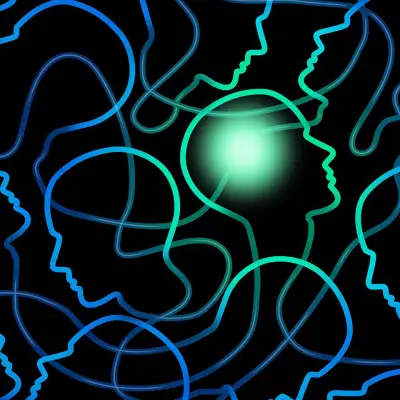Feeling left behind or fearing that the people we love will leave us can be a deeply unsettling experience. It's something many of us may go through at some point.
If you're reading this, perhaps you're looking for answers about abandonment issues – either for yourself or someone close to you. Understanding these feelings is the first step toward healing. Let's dive into what abandonment issues are, their signs and symptoms, and, most importantly, how to overcome them.
Jump to:
Understanding Abandonment Issues

At the heart of abandonment issues lies a deep-seated fear that the people you care about will leave. This fear can stem from experiences in childhood, such as the loss of a parent, neglect, or inconsistent caregiving, but it's not exclusive to early years. Adults can develop abandonment issues after significant relationships end or through experiences that shake their sense of security and belonging.
What Causes Abandonment Issues?
Abandonment issues can stem from various experiences, each affecting people in deeply personal ways. Here are some common causes:
- Early Childhood Experiences: The foundation for feelings of security and trust is often laid in your earliest years. When these basic needs are not met due to neglect, loss of a parent, or inconsistent caregiving, it can lead to a fear of abandonment later in life.
- Parental Divorce or Separation: Witnessing the breakdown of parental relationships can profoundly impact a child's sense of stability and security, fostering fears of abandonment.
- Death of a Loved One: The loss of a close family member or friend, especially during formative years, can instil a deep fear of losing others.
- Betrayal of Trust: Experiences of betrayal, such as infidelity or backstabbing by someone close, can shake the foundation of trust and lead to fears of abandonment.
- Relationship Breakdowns: Ending significant relationships, especially if the endings are sudden or unexpected, can trigger abandonment issues in adults.
- Traumatic Events: Traumas, including accidents, natural disasters, or witnessing violence, can increase feelings of vulnerability and fear of loss.
- Being Left Alone or Isolated: Experiences of being left alone for extended periods, especially in childhood, or feeling isolated from peers can contribute to abandonment fears.
Signs of Abandonment Issues
Recognising the signs of abandonment issues is an important step on the path to healing. These signs can manifest in various ways, impacting both personal well-being and the health of relationships. Let’s delve deeper into each of these signs:
1. Difficulty in Trusting Others
One of the most noticeable signs of abandonment issues is difficulty in trusting others. This is a deeply rooted worry that, at their core, people are not reliable or safe. This fear can make forming new relationships incredibly challenging and lead to a cycle of isolation or superficial connections. Trust, or the lack thereof, becomes a significant barrier, preventing deep and meaningful bonds from forming.
2. Sabotaging Relationships
Sabotage in relationships is often a subconscious effort to protect yourself from the perceived inevitability of being abandoned. This can look like pushing people away, finding faults in partners that aren’t there, or creating problems that don’t exist. It's as if there's an inner voice constantly questioning the stability of relationships, leading to actions that might bring about the most feared outcome: ending the relationship prematurely to avoid the pain of being left.
3. Clinging to Relationships
Abandonment issues can also lead to clinging too tightly to relationships, even those that are unhealthy or no longer serving you. There's a persistent fear that being alone means being unlovable, so you might stay in situations that are detrimental to your mental or emotional health. This clinging isn’t about the joy of the relationship but the fear of being alone and the feelings of worthlessness that might accompany solitude.
4. Experiencing Severe Separation Anxiety
Separation anxiety is not exclusive to children. Adults with abandonment issues may experience intense anxiety at the thought of being separated from those they are attached to. This can manifest as physical symptoms of anxiety, such as palpitations, sweating, or panic attacks when faced with actual or perceived separation. It’s an overwhelming fear that separation, even temporary, might lead to a permanent loss.
5. Constantly Seeking Reassurance
A constant need for reassurance from partners, friends, or family members is another sign of abandonment issues. This reassurance seeks to temporarily calm the deep-seated fear that they might leave.
It can take the form of needing to hear affirmations of love, commitment, or merely the presence of the other person. While seeking reassurance is a natural part of any relationship, it becomes concerning when the need is constant and stems from a place of fear rather than mutual emotional support.
Healing Abandonment Wounds
The healing journey begins with acknowledgement. Recognising the presence of abandonment issues is a brave first step. From here, there are several paths to healing:
How to Overcome Abandonment Issues from Childhood
If your abandonment issues stem from childhood experiences, exploring these with a therapist can be incredibly healing. Therapy provides a safe space to unpack past traumas and understand their impact on your adult life. Cognitive-behavioural therapy (CBT) and other therapeutic approaches can help reframe your thoughts and reduce the fear of abandonment.
Navigating Abandonment Issues in Adulthood
For issues that have arisen in adulthood, building a support network of friends, family, and possibly a professional can provide a safety net. Learning to communicate your fears and needs effectively in relationships can also help reduce these issues. Practising self-soothing techniques and building your self-esteem can make a significant difference.
Building Trust and Security in Relationships
Trust is fundamental in overcoming abandonment issues. This involves trusting others and being trustworthy yourself. Setting healthy boundaries, communicating openly, and gradually allowing yourself to be vulnerable can foster trust and intimacy in relationships.
Finding Professional Help
Professional support is invaluable in overcoming abandonment issues. Therapists can provide strategies to manage anxiety, build self-esteem, and improve relationship skills. If you're unsure where to start, online directories or recommendations from trusted sources can be a good starting point. Or, you can look at our selection of online counselling courses to heal in your own time on your own terms.
How to Overcome a Fear of Abandonment

The fear of abandonment can be paralysing, touching every aspect of your life, from personal relationships to how you perceive yourself. Overcoming this fear is not an overnight process; it's a journey that requires compassion, self-awareness, and deliberate action. Here are four steps to help you overcome abandonment issues:
1. Understanding Its Origins
The first step in overcoming a fear of abandonment is understanding where it stems from. For many, this fear is rooted in early experiences of loss, neglect, or inconsistency in care.
Identifying these origins can illuminate why current situations trigger such intense reactions. This understanding alone can be empowering, offering a context for your feelings that explains a natural response to past pain.
2. Recognising Patterns
Fear of abandonment often leads to recognisable patterns in behaviour and relationships. These can include pushing people away before they can leave, choosing partners who are not fully available, or staying in unhealthy relationships out of fear of being alone.
Observing these patterns without judgment allows you to start making conscious choices to break them, gradually steering your life towards healthier interactions and self-perceptions.
3. Working Through Feelings
Confronting and working through feelings of abandonment involves acknowledging them as they arise and allowing yourself to feel them without being overwhelmed. This is where mindfulness and meditation can be invaluable.
By anchoring yourself in the present moment, these practices help you to observe your feelings from a distance, reducing their immediacy and power over you. Mindfulness teaches you to notice when fear is dictating your actions, allowing you to choose a different response.
4. Mindfulness and Meditation
Incorporating mindfulness and meditation into your daily routine can significantly help manage anxiety related to abandonment. These practices encourage a state of calm awareness, helping you to break the cycle of fear-based reactions.
With regular practice, you'll find it easier to stay grounded in the present, appreciating current relationships and experiences without the shadow of past fears looming over them.
How to Support Someone with Abandonment Issues

Supporting someone with abandonment issues is a delicate balance of providing reassurance, encouraging independence, and offering unwavering support. Here are ways to effectively support your loved one:
Patience and Understanding
Understanding that your loved one's fears aren't a reflection of your relationship but rather their internal struggles is crucial. Demonstrating patience when they seek reassurance or express unfounded fears shows they're valued and safe with you. This understanding fosters a supportive environment where they can express their fears without worrying about judgment.
Consistency in Actions and Words
Consistency is key in building trust with someone who fears abandonment. Your actions and words need to align, reinforcing the reliability and stability you offer. Small gestures of affection, keeping promises, and showing up when you say you will increase their sense of security in the relationship.
Offer Reassurance
While it's important not to enable dependency, offering reassurance when genuinely needed can help alleviate their anxiety. This might mean affirming your commitment to the relationship, expressing your feelings openly, or simply being there when they need you. It's about finding a balance that supports them without fostering co-dependency.
Encouraging Professional Help
If abandonment issues significantly impact your loved one's life, encouraging them to seek professional help can be a big step. Therapy can offer them strategies to manage their fears, heal from past traumas, and build healthier relationships. Supporting them in finding a therapist and possibly attending sessions with them (if appropriate) can demonstrate your commitment to their well-being.
What Are the 5 Stages of Abandonment and Recovery?
Understanding the journey through the stages of abandonment and recovery can provide insightful guidance for those navigating this challenging experience. Each stage represents a step in the healing process, from the initial impact of abandonment to the eventual recovery and moving forward. Let's delve into these stages:
1. Shattering
The shattering stage marks the initial shock and pain following abandonment. It's characterised by disbelief, sadness, and a sense of unreality. The world as you knew it has changed dramatically, and the loss feels all-consuming. This phase can be paralysing as the full impact of what has happened begins to sink in. Emotional turmoil is at its peak, accompanied by confusion and a sense of loss.
2. Withdrawal
Following the shock of shattering comes the withdrawal stage. This phase is similar to the symptoms of physical withdrawal from a substance, where someone craves the presence or connection with the person who has left. It's a painful longing for what was lost, marked by intense emotional pain. You may find yourself obsessively thinking about the person, rehashing memories, and feeling a deep sense of emptiness. Withdrawal underscores the deep human need for connection and the pain that comes from its loss.
3. Internalising
Internalising is the stage where self-blame and internalisation of the loss occur. It's common to start questioning what went wrong and to blame oneself for the abandonment. Thoughts like "If only I had done this differently" or "It's my fault they left" are common. This stage is particularly challenging because it can lead to a significant drop in self-esteem and self-worth. Understanding that the decision to leave was outside your control and not a reflection of your value is crucial in moving past this stage.
4. Rage
Rage can emerge as a powerful response to the feelings of helplessness and vulnerability experienced in the earlier stages. Anger towards the person who left or the situation that led to the abandonment is common. While rage can be destructive if not handled properly, it's also a sign of the healing process moving forward. It signifies the re-emergence of personal power and the refusal to be defined by the abandonment. Channelling this anger constructively, such as through therapy or creative expression, can be a key step in the recovery process.
5. Lifting
The lifting stage signifies the gradual recovery and the beginning of letting go and moving forward. It doesn't mean the pain is completely gone, but it indicates a significant shift in perspective. In this stage, you start to see possibilities for the future, rediscover your sense of self, and regain strength and optimism. Letting go of what was lost allows for new growth and opportunities to emerge. Lifting is the stage where the healing process brings about transformation, empowering you to rebuild a life enriched by the lessons learned from the experience of abandonment.
Each stage is a natural part of the healing process from abandonment. It's important to remember that everyone's journey through these stages is unique, and moving between them is not always linear. Patience, self-compassion, and support from loved ones or professionals help navigate this challenging path towards recovery.
Common Questions About Abandonment Issues
What Trauma Causes Abandonment Issues?
Trauma that leads to abandonment issues often involves significant loss or betrayal. This can include the death of a loved one, parental separation or divorce, or experiencing betrayal in a close relationship. Any event that significantly disrupts one's sense of security and belonging can potentially lead to abandonment issues.
What Do People with Abandonment Issues Need?
Those facing abandonment issues need empathy, understanding, and patience from those around them. They also benefit from consistent reassurance, stable relationships, and the opportunity to build trust in a safe environment. Professional support through therapy can provide strategies to address and heal these issues.
What Not to Do to Someone with Abandonment Issues
It's important not to dismiss or minimise the feelings of someone with abandonment issues. Avoid being inconsistent or making promises you can't keep, as this can exacerbate their fears. Similarly, pushing them too hard to "get over" their issues can be counterproductive and damaging.
What Does Abandonment Trauma Look Like?
Abandonment trauma can manifest as intense fear of loss, difficulty forming or maintaining relationships, and chronic feelings of insecurity or unworthiness. It might also lead to anxiety, depression, and, in some cases, attachment disorders.
Do Abandonment Issues Go Away?
With the right support and intervention, individuals can heal from abandonment issues. It requires time, effort, and often professional guidance, but progress and recovery are indeed possible.
Why Do People with Abandonment Issues Sabotage Relationships?
Sabotaging relationships is often a defence mechanism to avoid the pain of being abandoned. It's a way to take control of the situation by ending it before they can be hurt again, even if it's not in their best interest.
Are People with Abandonment Issues Controlling?
Some people with abandonment issues may exhibit controlling behaviours as a way to cope with the fear of abandonment, attempting to manage their environment and relationships to prevent perceived threats of loss.
How Do Abandonment Issues Manifest in Adults?
In adults, abandonment issues may show as reluctance to enter into relationships, fear of being alone, difficulty trusting others, and sabotaging relationships. Adults may also experience anxiety, depression, and a pervasive sense of insecurity.
Where Is Abandonment Stored in the Body?
Emotional pain, including that caused by abandonment, can manifest physically in various ways. Some may experience tension or pain in the chest, stomach, or muscles as the body holds onto stress.
What Does Abandonment Do to a Woman
Women, like men, can experience abandonment issues deeply, potentially impacting their self-esteem, relationships, and emotional well-being. They may struggle with trust and fear of being left and may either cling to or push away from relationships.
Do Narcissists Have Abandonment Issues?
Narcissistic behaviours can sometimes be linked to deep-seated fears of abandonment, with people developing mechanisms to protect themselves from perceived threats of rejection or loss.
What Happens When Abandonment Issues Are Triggered?
When triggered, a person with abandonment issues may experience intense emotional distress, anxiety, and a flood of fears related to being left alone or rejected. This can lead to withdrawal, confrontation, or seeking reassurance from others.
What Mental Illness Has Abandonment Issues?
Abandonment issues are not classified as a mental illness but can be a symptom or contributing factor to several disorders, including borderline personality disorder, depression, and anxiety disorders.
Should You Date Someone with Abandonment Issues?
Dating someone with abandonment issues requires understanding, patience, and a willingness to support them through their healing process. It's essential to communicate openly and ensure you're both on the same path towards building a healthy relationship.
How Do You Love with Abandonment Issues?
Loving with abandonment issues means actively working on trust, communication, and self-awareness. It involves being honest about your fears, seeking professional help if necessary, and building a foundation of stability and reassurance in your relationships.
Recommended for you!
Best SellersDiscover Healing with Centre of Excellence
Take your first step on a journey of self-discovery and healing with our Attachment Theory Diploma Course, crafted to explore the depths of attachment styles and the roots of abandonment issues.
Why Centre of Excellence?
- Accessibility: We firmly believe that transformative education should be accessible to everyone. That's why we've made our courses affordable, ensuring that anyone eager to learn and grow has the opportunity to do so.
- Flexibility: Our courses are designed with your lifestyle in mind, allowing you to learn at your own pace. This flexibility makes it easy to weave your educational pursuits into your daily life, accommodating your personal and professional commitments.
- Comprehensive Curriculum: Delve into a wide range of topics related to attachment theory, abandonment issues, and healing. Our curriculum is extensive, catering to various interests and providing the tools necessary for personal growth and the support of others.
- Dedicated Support: Enrolling in our course means accessing dedicated tutor support and joining a community of like-minded learners. This support network provides guidance and encouragement throughout your educational journey.
Special Offer
We're excited to offer our Attachment Theory Diploma Course at the exceptional price of £29, saving you over £100!













